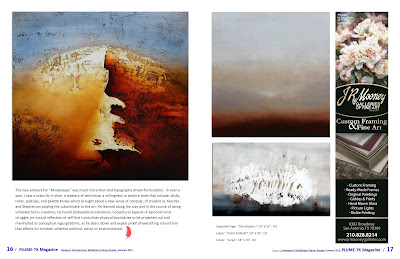J.R. Mooney Galleries-Boerne Gallery Director, Gabriel Diego Delgado shares his thoughts with Plumage-TX Magazine on the curatorial basis behind the "Mindscapes" exhibition. You can read the full article at:
“Mindscapes”
Russell Stephenson
J.R. Mooney Galleries-Boerne
By: Gabriel Diego Delgado,
Gallery Director - Boerne
“Mindscapes,” a solo
exhibition of new work by San Antonio artist, Russell Stephenson, is a curated
spotlight of art that engulfs the viewer into a metaphysical journey through sci-fi-esque renditions of Texas topography, juxtaposed
and coupled with the artist’s own exploration of mind and world shaped by personal afflictions.
From violent thunderclouds masquerading as crowns for celestial auroras of heavenly
atmospheric amalgamations (halos) in Corona,
to canyons and mountains portrayed as conceptual struggles in identity, an
artist’s simplified battle of good vs. evil, in The Majestic, we feel an undercurrent of cosmic exploration with a
signature medium by way of a quest for self-discovery. Current events like the recent flooding in
South Texas, the massive supercells over the Texas Panhandle and the artist’s
own drive to experiment all play a role in Stephenson’s influences for “Mindscapes”. Examples of emotion abutted by landscape
explorations can be found in the calmness of mind of “Silent Solitude,” but contrasted in “Castleaine” with its compositional angles; assumptive tectonic
plates that jut upward, forced from the subterranean by violent burst of the grinding
fault lines.
With the inclusion of two artworks from the “Cave Painting” series, “Cave Painting III & V”, the
audience delves into the past with visual investigations of the primordial gestures
of primitive man: a rock art aesthetic that references the cave paintings of
Lascaux, Texas’s own Pecos region and Palo Duro Canyon. Stephenson strives to
capture the intuitive application of creative need in his own color palette
aesthetic while retaining his mastered craft for his push and pull of textures
– i.e. the divots, cracks, creases, and pockets of layered grooves that capture
our wild imaginations. The scraped and
gouged paint give rise to his pursuit of reconnection to art history by way of
contemporary applications.
When I recently met with Russell Stephenson at his Alamo
Heights studio we had already been discussing “Mindscapes” on the phone, in text and via email for about four
months. To see the artwork in person
prompted a crisscross of casual conversations mixed with a professional
inquiry. I saw a change in his mood, a
kind of creative uncertainty mixed with a newly acquired cynicism of
contemporary art market vitality. I
heard of his new gallery prospects in Santa Fe, New Mexico, of disappointments
with the regional affairs and ways in which he felt his artwork was going to
mature. This insightful off-the-cuff
conversation led me to further investigate the ways in which to formulate his
exhibition.
As our conversation continued in the studio, it led to
Stephenson’s other Texas galleries and the bodies of work he needed to execute
for them; each one exhibiting a different series ranging from strict grid
patchwork designs to formal abstractions.
Over the course of the last few years he has deliberated how to blend
these styles into one pure signature aesthetic.
His techniques and medium manipulations in any of his series reflect a
signature Russell Stephenson touch, but each gallery wanted visuals that
appealed to certain demographics and art markets.
I began to understand he was starting to figure out a way to
deviate from gallery dictated ventures to creating something new, a compilation
of sorts for all of his contractual obligations he was fully invested in. This thoughtful approach was refreshing to
hear, as he was beginning to understand how to dig out from his muddled aspects
of five separate directions to one strong maturity.
In 2013/2014, J.R. Mooney Galleries had previously shown
only Stephenson’s Texas Panoramic
series, a kind of middle ground aesthetic that melded with the gallery’s fundamental
branding that has always included traditional impressionistic aesthetic mixed
with portrait, landscapes and Tuscan paintings. Stephenson’s abstracted Texas
landscapes gives us horizon lines that grounded us in traditional landscapes of
geographical locations we could digest; a kind of concrete middle ground that
fit in between the abstract and traditional genres.
The new artwork for “Mindscapes”
was much more than that topographically driven formulation. In over a year, I saw a maturity in style, a
mastery of technique and a willingness to explore tools that included sticks,
rocks, spatulas and palette knives, and which brought about a new sense of
control, of student vs. teacher, and Stephenson playing the subordinate to the
art. He learned along the way, and in
the course of being schooled by his creations, he found philosophical
substance. Conjectural aspects of
personal inner struggle, an inward reflection of self that transcribes physical
boundaries to be projected out and manifested as conceptual regurgitations, as
he bears down and expels proof of everything around him that affects his
mindset - whether political, social or environmental.






No comments:
Post a Comment
Note: Only a member of this blog may post a comment.